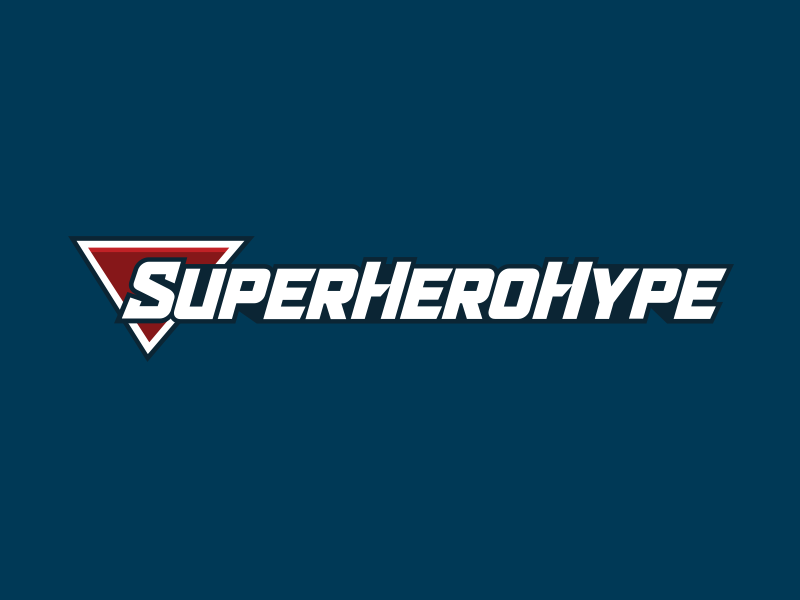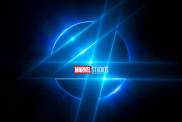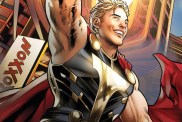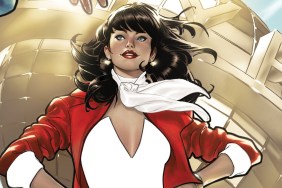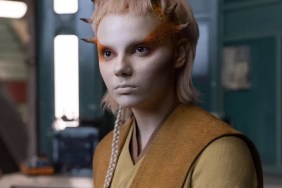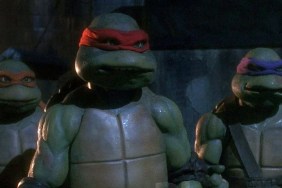In a couple months, fans of ultra-violent superhero action will finally get their chance to see Matthew Vaughn’s Kick-Ass when it hits theaters on April 16… hard. The new trailer has gotten a lot of fans excited, but last year at Comic-Con International in San Diego, SuperHeroHype was thrilled to have a chance to spend some time with the creative team on both sides of the camera to get a taste of what we might expect.
Kick-Ass is Vaughn’s third movie after the British crime-thriller Layer Cake and his adaptation of Neil Gaiman and Charles Vess’ Stardust, but the story behind his new movie begins with the creators of the 8-issue “Kick-Ass” mini-series, Mark Millar and John Romita, Jr. The thought of these specific comic creators working together boggles the mind, because they couldn’t be any more different: Millar being a quick-talking ginger-haired Scotsman who tends to love subversively flying in the face of mainstream superhero traditions as seen in his graphic novel Wanted, which was turned into a hit action movie by Russian filmmaker Timur Bekmambetov. Romita is the son of another Marvel legend, the two of them having helped build Marvel’s House of Ideas for over forty years, as Romita, Jr. drew Spider-Man, X-Men, Iron Man, Thor and just about every other Marvel hero at one point or another. Essentially, Romita, Jr. can be seen as a perfect example of mainstream superhero graphic storytelling.
Millar certainly allowed Romita to break away from that when they collaborated on the story of David Lizewski, played in Vaughn’s movie by Aaron Johnson, a geeky comic book nerd who decides to put on a costume and fight crime, only to find out fighting crime isn’t as easy as Spider-Man makes it look. Along the way, he meets fellow heroes Red Mist (Christopher Mintz-Plasse), and the father-daughter team of Big Daddy and Hit Girl (Nicolas Cage and Chloe Moretz).
Vaughn got involved very early on in the process, scooping up the movie rights and developing the movie concurrently with the comic being released. The comic series itself has been a long time coming, the first issue having been released in February 2008 with many fingers crossed that the last issue might be in shops before the movie opens in April.
We’ll start off with our interview with Millar (on the right) and Romita, Jr.:

SuperHeroHype: I gotta say that I’m a big fan of both of yours, so I’m glad you finally got around to working together.
Mark Millar: Well, thanks very much, thank you. I think it’s a bit like when Scorsese met De Niro kind of thing… and they ended up working together all the time.
John Romita, Jr.: Speaking of De Niro, wasn’t De Niro at one point a chance they were trying to get him to be Big Daddy?
Millar: Yeah, there was talk of it, and there was talk of him playing the gangster as well. He’s very expensive though, De Niro.
Romita: Yeah, he wouldn’t budge on his price.
Millar: $20 million, but you know what? He’s got a lot of kids out there to pay for and all that, and I think he likes the cash now.
SHH: It’s funny, because I would see it more as Scorsese meeting Walt Disney, ’cause John, you’ve been doing so many mainstream superhero comics for so long and not really done any mature stuff at all.
Romita: Did you ever see a movie with Julie Andrews, “S.O.B.”? If you’ve seen it where this puritanical perfect angel of actress drops the bra… Julie Andrews! You see her chest for the first time. I felt that way, because I’ve never drawn anything so violent before, but as I started doing it, I started to salivate… this is great! It was like a guilty pleasure, I was enjoying it so much, but it wasn’t just ’cause of the visuals, it’s from working on his stuff. He’s just got a great, great knack for coming up with new flip-flops and twists and turns and yanking chains. He should be writing movies, the hell with comics!
SHH: How did you pitch the comic to John?
Millar: I wouldn’t have done it if he wasn’t available, I’m not kidding, because I actually have a lot of creator-owned things in the back of my head and I’m waiting on various pals to be finished with things to go and do it. I don’t know why. It must be some form of autism but once I actually get an artist in my head for something, I can’t imagine someone else doing it. I just knew that with Johnny, if there was as “Goodfellas” comic you’d be great at it. Just the idea that you could bring that quiet realism. Although your art is a realistic art, it’s also stylized, it’s not like that Alex Ross painted look, but it’s got an energy that that stuff doesn’t have. It’s not stilted in any kind of way that photographic art is, but it still feels incredibly real, definitely. It’s the same way as when Scorsese shoots something. It just makes me think of “Taxi Driver” and steam coming up out of manholes and all that. Johnny’s just the perfect guy for that, and for “Kick-Ass,” that was the world I saw in my head, even before I saw the costume, I knew and genuinely, I imagine Curt Swan could have drawn it, but it just works. It had to be Johnny or no one. I could have just left it and gone and done something else.
SHH: It’s funny you should mention Curt Swan, because I remember that issue of “Swamp Thing” you wrote for him and it was the most subversive thing he has ever drawn in his life.
Millar: He died shortly after finishing my thing.
Romita: Is that right? Oh my God.
Millar: The thing he drew was so obscene.
Romita: (Mark) actually offered me an alternative. He said, “If you don’t want to do this, we can do something else, something more mainstream to make a couple of bucks, but if you want to take a chance on something…” Because we didn’t get any money up front for this, and I was, “Yeah, what the hell, let’s try something different” and it came to this, so I made a gamble and it actually paid off for the first time. I got lucky.
SHH: So how has it been working with Matthew? What was the process for this movie happening? Did he come to you with money to option it and that was it?
Millar: No, no. Matthew and I have a couple mutual friends, like Jonathan Ross and Jane Goldman, she’s one of the screenwriters and she worked on “Stardust” with Matthew. I’d just been up at their house and got to know Matthew through them and I was at the “Stardust” after party and Matthew said to me at the party, “Oh, it’s not working out with ‘Thor’ and now that ‘Stardust’s’ finished, I’ve got nothing left to do. Have you got anything that you own?” I said, “Well, a couple of things” and I told him about “Kick-Ass” and I’d only written the first two issues. He said, “Send it then and send me the plot for the rest of it.” I fired it down and he loved it and he said, “Do you mind if I just start writing the screenplay?” and I’m like, “Yeah, of course.” It was totally informal. The agents found out about it later.
SHH: Has he been using your art as storyboards almost? Has he been able to do that at all?
Romita: I don’t know if he’s been doing it to that extreme. He wanted it to be close to the book and he’s taken some scenes from it. As far as the extent of that, I’d have to see the whole film, but from what Mark tells me, he’s gone to the comic several times.
SHH: So far, from what was shown downstairs, it looks like it was taken directly from the first six issues?
Millar: Well, it’s scene for scene pretty much. Unfortunately, eight issues would probably make a hundred minute movie, maybe slightly less, or maybe 80 minutes it works out as, so they had to add some stuff in, just to stretch it out a little more so it would become a feature, so they added a couple little extra things. But that’s fine. An adaptation’s got to really… because one thing’s a comic and one thing’s a movie.
SHH: Is the movie going to end right where the mini-series ends?
Millar: Oh, exactly where it ends. It starts and ends with the exact shots, the exact locations. Johnny’s art is almost the storyboards for the movie, but the thing I quite like about it is that it’s quite subtle the way that’s done. Only Johnny and I and ???,
like when Kick-Ass is hit by the car, that’s pretty much the shot that was taken, but he suggested a different car, though.
Romita: Yeah, he did say that.
Millar: But it was the exact shot, because it was just that way he was upside-down and coming over the back of the car, which is how Johnny drew it in the comic. I liked that, the subtlety of that. It wasn’t that in-your-face way of “Sin City” where it looked like a comic book moving. It definitely alienates a mainstream audience. Anybody can watch that and not realize it’s a comic book, but anybody whose read the books can go, “Oh, sh*t, that’s John’s panel,” yeah?

SHH: I’ve spoken to Timur and the writers of “Wanted,” and I remember when they did that, they only had the first book to work from, so this one will be a lot closer to the story in the comics, I guess.
Millar: Yeah, yeah. “Wanted,” the first two issues, ’cause all that training stuff was the first 58 minutes, and after that, they did their own thing. The first half was mine and the second half was theirs, and I was fine with that. The people who read the “Bourne” books, it’s nothing like the “Bourne” movies. The Bond movies, it’s just the name of the character and a vague situation. That’s movie adaptations, you know? For this, to be so close is very unusual, but luckily, it works. “Watchmen” it didn’t quite work, but luckily, “Kick-Ass” is quite a cinematic book anyway, so it works out okay.
SHH: John, you drew both “Spider-Man” and “X-Men” and none of those movies have quite captured how you make them look in terms of the action.
Romita: Actually, my drafting style, to me it’s fair to midlands as far as quality goes, but my storytelling makes it better. I’ll embrace the fact that my storytelling is quality and I have a certain sense of broad cinematic shots that I really feel strong about, and it seems to be picking up in people’s minds that that was my foray into the film business, and now to have somebody pick it up, I didn’t expect it. I’m not doing things consciously. I do them just because it comes out of me, and I hear that a director likes (what I do). He’s always said I had a cinematic style, and I just think of it as a nice compliment from a friend, but to have Matthew pick up on it, I hope that’s a trend. (laughs) I would love it to be that way, but it’s flattering beyond any… someone tells you they love your work, it’s great. When somebody emulates it on film, that’s a compliment.
Millar: And for somebody to raise $50 million of their own cash and their friend’s cash to make it come to life is the biggest compliment you can get really.
Romita: Absolutely.
Millar: Maybe $45 million, but that’s a hell of an investment, isn’t it? To believe in something to that extent to the point where… it would have been a lot easier for him to compromise the screenplay, which was how they made “Wanted.” He actually stuck to what it was, and I think it’s unheard of in cinema. I don’t think that’s ever happened before.
SHH: Usually when you do a self-financed comic like this one, you have to see how it does before you do another one. “Kick-Ass” has obviously been a huge success, so are you guys going to start another mini-series right away?
Millar: Well, with issue one, there’s five of them, it’s crazy. There’s five editions of it, and I think each one has done about 100,000.
Romita: I’ll be done with issue 8 in about three weeks (note: this interview is from last July) and I’m ready, willing and Mabel to do the next set.
SHH: When you do the second mini-series are you going to think more about what might happen in the movie and bring some of that into it?
Millar: Well see, if you start thinking like that, you end up screwing up. You just gotta do what feels fun and right. All the way through this, it’s been hard, because you’re not really making a film. You just think that this has got to be a good comic. Or else, the minute you try to think what’s going to be on film, you’ve lost it.
SHH: It’s interesting how the movie has been happening almost at the same time as the comic, so the more people found out about the movie, the more they were getting into the comic, which also isn’t something we’ve seen that often.
Millar: Yeah, yeah, and it’s going to go nuts when the film comes. The graphic novel I think is going to be insane.
SHH: Are you going to be involved in the sequel to “Wanted” at all? I’m actually talking to Timur in the morning.
Millar: Is Timur here?
SHH: Yeah, he’ll be here tomorrow because he’s producing the animated movie, “9.”
Millar: Oh, man, I’m away tonight! Yeah, I’m a story consultant on it, because obviously they mined almost everything from the book. Like there’s some stuff they couldn’t, but other than the more comic booky stuff that was too much, they kind of got everything they wanted. They’ve got this idea for an international group of assassins from issues 4 and 5, and that’s going to sort of be the basis for “Wanted 2.” The screenplay is pretty much done now, there’s been quite a few drafts, and I think they start filming in about eight weeks time. (Note: Okay, obviously that hasn’t been the case.)
Later, we had a chance to speak with Matthew Vaughn. Because we hadn’t seen the movie and Vaughn hadn’t even finished it at that time, we couldn’t get too in-depth and just had to base our questions on the footage we had seen, which you can read about in our earlier Comic-Con coverage.

SuperHeroHype: I loved the footage I saw. It looked like it really captured what I liked about the comic book. When I spoke to Mark, he told me a little bit about how this came about, but why did you decide to finance it independently?
Matthew Vaughn: I had no choice. Every studio said “No.” They all turned it down.
SHH: What was their reasoning? Too violent?
Vaughn: You’d have to ask them. Seven “No’s.”
SHH: So you decided to finance and make it yourself… What was it about the idea that made you want to make it a movie? It is very different “Stardust” obviously.
Vaughn: It’s a very unique story and it’s fun and it had stuff I hadn’t seen before, and I just knew I could make a good film.
SHH: At that point when you decided to do it, were there any comics done?
Vaughn: No… they gave me a synopsis of what it was going to be and I thought, “This is cool. Let’s go do it.”
SHH: As far as the casting, I think Nicolas Cage surprised everyone and he seems to be doing something different than his usual thing. How did you approach him to do this considering that he’s probably used to getting a good chunk of money?
Vaughn: Just ring up and he read the script and liked it, and said, “I’m in.”
SHH: What about the casting of Chloe as Hit Girl? She’s great in “(500) Days of Summer,” had you seen that?
Vaughn: I haven’t, no. She’s great.
SHH: I assume you shot this last year some time, right?
Vaughn: I shot it… We started in September to November.
SHH: So how did you find her?
Vaughn: Auditions. She came in and she blew me away and she trained hard, and she was a wonderful discovery.
SHH: From what I’ve seen, the movie has more of an American feel than anything we might expect from you even though you did shoot a lot of it in England.
Vaughn: I hope this is American. I don’t know, but I tried to make an American movie.
SHH: Was that also something that interested you about doing this?
Vaughn: Yeah, I grew up watching American movies so I wanted to make an American film. Hopefully I’ve done it.
SHH: What were some of the influences? Did you have any visual influences besides the comics?
Vaughn: Visually, I just wanted to make it look like a high-gloss, sort of glossy American film, so what happens in the film is shocking, not the style. We all have seen this type of movie before, but then you’re like, “Or maybe I haven’t.” So I was just trying to make it very bright and colorful.
SHH: It looked very different, kind of gritty but lots of colors, because we’re used to the Frank Miller look which is very dark.
Vaughn: I just let the characters do the dark stuff and let the lighting be… I just thought it would be interesting to juxtapose the look and the action.
SHH: What we saw downstairs, was that the toned-down version of the gore that we saw? When she was slashing people, we weren’t seeing blood spraying or anything like that.
Vaughn: Um… Or we haven’t done that yet. That stuff’s gotta be added. I mean, we’re not going to go mental with the blood, but we haven’t actually decided to be honest. We’re experimenting with lots of them at the moment.
SHH: I was curious, because I know when you show footage at Comic-Con, they have very specific ground rules, but you have so much swearing in this, I can’t imagine they’d take issue with the blood.
Vaughn: They were very cool, Comic-Con, to their credit, because they were really nervous about using the “C”-word, and then they went, “You know what? We shouldn’t be censoring this, just play it.”
SHH: What about Chloe’s mother? Did she have any issues with the language she’d be using?
Vaughn: No, I dunno, you’d have to ask her.

SHH: When I saw “(500) Days” again recently and realized she was going to play Hit Girl, I really could see it.
Vaughn: Well, she’s the real deal.
SHH: I wanted to ask about the trailer you showed. Was that just something you cut together yourself?
Vaughn: We haven’t got a studio yet, so there’s a trailer house called Empire in England who are helping us out as well, who are doing a brilliant job, so we’ve been working with them. So it’s been good.
SHH: Where do you go from here? How much more work do you have to do to the movie before it’s done?
Vaughn: I think we’re about four weeks away from locking picture and then about two or three months of getting visual FX and the music right and then it’s done.
SHH: Are you still involved in producing and helping other filmmakers get their projects made?
Vaughn: No, just directing at the moment. I’ve got my hands full right now. Producing, directing and writing doesn’t give you much time to try and be a good father? Your day’s over.
SHH: Downstairs, I think you said something about the clips all being from the first act and that you’d bet your kids that the rest of the movie delivers just as much.
Vaughn: Nah, I said that all of it was from the first act and there were some better scenes. And just ’cause you hear bullsh*t all the time, so I thought “Hold on, I better say that I mean it.” So maybe I shouldn’t have said that.
SHH: Have you stayed in touch with Guy Ritchie at all and have you had a chance to see any of what he’s been doing on “Sherlock Holmes”?
Vaughn: No, I haven’t spoken, but I’ve Emailed Guy… we’ve been Emailing a bit, but I have seen nothing of “Sherlock Holmes.”
SHH: Are you going to try to check some of it out tomorrow?
Vaughn: I think I have to go back to L.A. ’cause I’m meeting some music guys in L.A. so I’ll be very intrigued by that.
SHH: What we heard downstairs, was that just temp music? Are you looking for all original score?
Vaughn: Yeah, we’re doing all original score. We’ll have some tracks in as well, but that’s the last thing for us to figure out is the music.
SHH: As far as your relationship with comics books, do you think you’ll continue in that direction?
Vaughn: I’d love to. I’d love to. In an ideal world, I’d like to do the big version of a superhero film. I’d like to do my “Dark Knight” but with a different character. Big epic comic book superhero film.
SHH: How far did you get into “Thor” before you left that?
Vaughn: Well, we got the script done and we started prepping. I was really excited and then… I still don’t quite understand what happened but I just think they had to wait and they couldn’t greenlight it when I wanted to make it, so that’s why I went off and did “Kick-Ass.” It’s like, “You know what? I want to be the master of my own destiny.”
SHH: I was just watching Terry Gilliam downstairs earlier and he seems much happier just doing what he wants to do, which is harder when you’re working with a known property or a studio thing, and you’ve dealt with both at this point.
Vaughn: It’s much more fun doing it on your own.
SHH: But isn’t it scarier putting all of your own money into it?
Vaughn: Uh… no. It’s a bit more pressure but it’s more fun because you haven’t got anyone interfering, so it’s worth it, you know? I dunno. I had such a good time making this movie that I look forward to doing it again.
SHH: Hopefully Mark and John will get going on the second volume.
Vaughn: We’ve got a whole great idea for a sequel. If the film does well, we’ve got a sequel that’s f*cking out there.
SHH: It’s great timing to have started working on the movie as the comic was being released and people were getting more and more excited for it, and I think it played great downstairs. To me, that was almost like a “300” moment, from what I’ve seen so far.
Vaughn: Wow. Well, spread it out there.
While we were waiting for Vaughn to be done with a few other interviews, we got a few moments with the lovely and talented Jane Goldman, the screenwriter of Kick-Ass, who also adapted Neil Gaiman and Charles Vess’ Stardust for Vaughn to direct:

SuperHeroHype: I was a huge fan of “Stardust” and I remember you were here a few years ago with that. You were friends with Mark Millar and he was at the party for “Stardust” and this is sort of how this came about?
Jane Goldman: Right, pretty much. In fact, Mark had said to me that he was very excited about what he was working on and he said, “I feel like I have one of my best ideas ever. It would make a great movie.” He knew I had just worked with Matthew and he said that he’d love to talk to Matthew about it, so he came over to the “Stardust” party and they got talking and that was kind of how it started.
SHH: Had the book even come out at that point?
Goldman: No, no, I think he had a finished script of the first issue and pretty much had the next three issues after that done, but those were the really early days.
SHH: Did Matthew say he wanted to have you write it or did Mark suggest you or was it a combination of the two?
Goldman: Matthew and I had just worked together on two projects, so it was…
SHH: You were working on “Thor”?
Goldman: No, we had another movie called “The Debt” which is completely different from “Stardust,” and no, we’ve just been working together a long time and I guess, this just kind of came up. But yeah, I knew both of them and Matthew and I happened to be working together and it was great and I’m happy to do that as long as Matthew wants me.
SHH: So what was the process for adapting this? When you started it, there must have been a couple issues out but not the whole thing.
Goldman: There were no issues out when we started, and he had the script on about four issues, so it was a completely different experience than adapting “Stardust.” So it was a completely different experience than writing something that was already finished and out there. “Stardust” had been out for eight years, but “Kick-Ass” is such a strong concept that it wasn’t a matter of “Where are you going with it?” I think it was really clear and we all had conversations together and Mark and Matthew had conversations about where Mark was taking the story, and where Matthew wanted to take the story. It was not as stick a situation as it sounds on paper maybe.
SHH: With “Stardust,” you definitely seemed to capture Neil’s voice, which is not something we’ve really seen in many comic book adaptations.
Goldman: Oh, thank you!
SHH: And this one, at least from what I saw downstairs, you seem to have captured Mark Millar’s voice, too, which is completely different! Is it easy to switch heads to maintain your own style as a writer but also keep what makes their writing so distinct?
Goldman: Thank you! I don’t know. Their voices are suggested so much by the material, but I guess you hear the characters’ voices in your head, so in a sense, that is the author’s voice of the original work, but I dunno. That’s the challenge that I enjoy, doing things that are totally different from one another.
SHH: This also seems to have more of an American voice than “Stardust.”
Goldman: Yeah, that was enormous fun. I spend a lot of time in America, but I really enjoyed that challenge to see if we could slip it past anyone, where they’d be able to guess that it was written by a British writer.
SHH: And what’s going on with the other movie you did with Matthew, “The Debt”? Is that looking for financing?
Goldman: No, that’s finished and coming out next year, it’s with Miramax. That’s all done, but Matthew didn’t direct that one. He produced it and it was directed by John Madden who did “Shakespeare in Love.” As I say, it couldn’t be more different from both “Stardust” and “Kick-Ass.” (laughs)
Kick-Ass opens on April 16, but it will also kick-off the 2010 SXSW Film Festival in Austin, Texas on March 12.
Source: Edward Douglas
